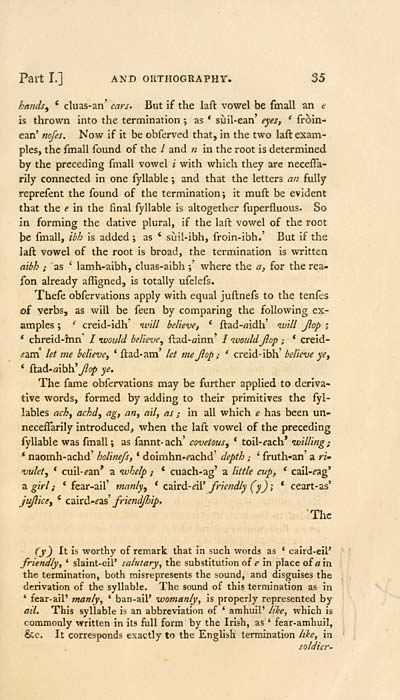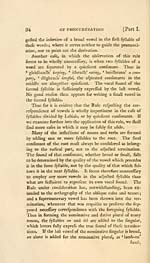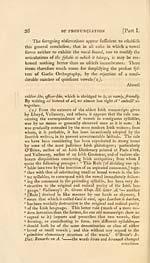Download files
Complete book:
Individual page:
Thumbnail gallery: Grid view | List view

Part I.] AND ORTHOGRAPHY. 35
hands, ' cluas-an' ears. But if the laft vowel be fmall an e
is thrown into the termination ; as * sùil-ean' eyes, * froin-
ean' nofes. Now if it be obferved that, in the two laft exam-
ples, the fmall found of the / and n in the root is determined
by the preceding fmall vowel i with which they are necelTa-
rily connected in one fyllable ; and that the letters an fully
reprefent the found of the termination; it muft be evident
that the e in the final fyllable is altogether fuperfluous. So
in forming the dative plural, if the laft vowel of the root
be fmall, ibh is added ; as ' sùil-ibh, froin-ibh.' But if the
laft vowel of the root is broad, the termination is written
aibh ; as ' lamh-aibh, cluas-aibh ;' where the a, for the rea-
fon already afligned, is totally ufelefs.
Thefe obfervations apply with equal juftnefs to the tenfes
of verbs, as will be feen by comparing the following ex-
amples j '^ creid-idh' ivill believe, * ftad-aidh' will Jlop i
' chreid-mn' / tuould believe^ ftad-oinn' / luetildjiop ; * creid-
^am let me believe, ' ft ad- am' let me Jlop ; ' creid-ibh' believe ye,
' ùad.aihh' Jlop ye.
The fame obfervations may be further applied to deriva-
tive words, formed by adding to their primitives the fyl-
lables ach, achd, ag, an, ail, as ; in all which e has been un-
neceflarily introduced, when the laft vowel of the preceding
fyllable was fmall; as fannt-ach' covetous, * toil-^ach* willing;
* naomh-achd' holinejs, * doimhn-*?achd' depth ; ' fruth-an' a n-
vulet, * cuil-^'an* a whelp ; ' cuach-ag' a little cup, ' cail-^ag*
z. girl ; * fear-ail' manly, * cuita-eW! friendly (y); * ceart-as'
jujlice, ' c-à\tò.-ezs friendjhip.
'The
(y) It is worthy of remark that in such words as ' caird-eil*
friendly y ' slaint-eil' salutary^ the substitution of ^ in place of a in
the termination, both misrepresents the sound, and disguises the
derivation of the syllable. The sound of this termination as in
' fear-ail' manly, ' ban-ail' womanly, is properly represented by
ail. This syllable is an abbreviation of ' amhuiP lihe, which is
commonly written in its fiill form by the Irish, as ' fear-amhull,
&c. It corresponds exactly to the English termination lihe, in
soldier-
hands, ' cluas-an' ears. But if the laft vowel be fmall an e
is thrown into the termination ; as * sùil-ean' eyes, * froin-
ean' nofes. Now if it be obferved that, in the two laft exam-
ples, the fmall found of the / and n in the root is determined
by the preceding fmall vowel i with which they are necelTa-
rily connected in one fyllable ; and that the letters an fully
reprefent the found of the termination; it muft be evident
that the e in the final fyllable is altogether fuperfluous. So
in forming the dative plural, if the laft vowel of the root
be fmall, ibh is added ; as ' sùil-ibh, froin-ibh.' But if the
laft vowel of the root is broad, the termination is written
aibh ; as ' lamh-aibh, cluas-aibh ;' where the a, for the rea-
fon already afligned, is totally ufelefs.
Thefe obfervations apply with equal juftnefs to the tenfes
of verbs, as will be feen by comparing the following ex-
amples j '^ creid-idh' ivill believe, * ftad-aidh' will Jlop i
' chreid-mn' / tuould believe^ ftad-oinn' / luetildjiop ; * creid-
^am let me believe, ' ft ad- am' let me Jlop ; ' creid-ibh' believe ye,
' ùad.aihh' Jlop ye.
The fame obfervations may be further applied to deriva-
tive words, formed by adding to their primitives the fyl-
lables ach, achd, ag, an, ail, as ; in all which e has been un-
neceflarily introduced, when the laft vowel of the preceding
fyllable was fmall; as fannt-ach' covetous, * toil-^ach* willing;
* naomh-achd' holinejs, * doimhn-*?achd' depth ; ' fruth-an' a n-
vulet, * cuil-^'an* a whelp ; ' cuach-ag' a little cup, ' cail-^ag*
z. girl ; * fear-ail' manly, * cuita-eW! friendly (y); * ceart-as'
jujlice, ' c-à\tò.-ezs friendjhip.
'The
(y) It is worthy of remark that in such words as ' caird-eil*
friendly y ' slaint-eil' salutary^ the substitution of ^ in place of a in
the termination, both misrepresents the sound, and disguises the
derivation of the syllable. The sound of this termination as in
' fear-ail' manly, ' ban-ail' womanly, is properly represented by
ail. This syllable is an abbreviation of ' amhuiP lihe, which is
commonly written in its fiill form by the Irish, as ' fear-amhull,
&c. It corresponds exactly to the English termination lihe, in
soldier-
Set display mode to: Large image | Transcription
Images and transcriptions on this page, including medium image downloads, may be used under the Creative Commons Attribution 4.0 International Licence unless otherwise stated. ![]()
| Early Gaelic Book Collections > Blair Collection > Elements of Gaelic grammar > (65) |
|---|
| Permanent URL | https://digital.nls.uk/79040755 |
|---|
| Description | A selection of books from a collection of more than 500 titles, mostly on religious and literary topics. Also includes some material dealing with other Celtic languages and societies. Collection created towards the end of the 19th century by Lady Evelyn Stewart Murray. |
|---|
| Description | Selected items from five 'Special and Named Printed Collections'. Includes books in Gaelic and other Celtic languages, works about the Gaels, their languages, literature, culture and history. |
|---|

